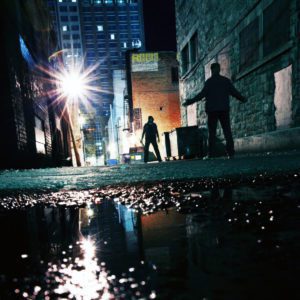30 Day Challenge/Day 27: Self Defense Simulations
On YouTube there are tons of videos that show remarkably intricate self-defense combinations and interactions by skilled Martial Artists. However there are also just as many real life situations you can watch where you see very little skills and lots of failures. Yet, often times in the end you will see the defender come out as victorious as the skilled Martial Artist. Maybe not as skillfully untouched but victorious non-the-less.
It is important to understand that the skilled videos has a level of control. Even if they attempt to portray the event as spontaneous. It can’t be. At the given moment that it was even known that it was a “training” session the event was affected by everyone’s attitude. Like Schrodinger’s cat a theory in quantum physics that illustrates how the observer affects the outcome of a scenario. If anyone in the scenario knows it is a simulation the entire event is influenced. This influence creates a known sense of safety which then allows for a freedom from anxiety that one might have to contend with in a real encounter.
It is so important to understand that training is just that; TRAINING. It is the best we can do to prepare for the actual encounter. We never truly know what might affect the outcome but the more we can control just in ourselves, the more we can influence it. In our preparations, every aspect of our training from; visualizations, to individual “air” repetitions, to simulated attacks, to spontaneous simulations all help us to find “Recognizable” moments in our “self,” our environment, the situation and the eventual outcome.
We can work to increase the intensity of our simulations, however again they are influenced by our awareness. Still it is a tremendous opportunity to work for failure. In fact the more we fail, the more we understand what not to do and it helps us to focus on what to do and how to adjust when things start going bad. These simulations truly do allow for us to “slow things down.” Even though the simulation is not “real,” the speed of ACTION again helps us to improve our Awareness Levels. Ideally we no longer pay attention to ourselves momentarily but we do so continuously. Instead of an on/off switch it is more like a dimmer switch. It is always on and we just turn it up when the situation arises. With this we are ahead of the game now ready to avoid distractions and focus on Environment, Situation and choose our responses.
In the simulations we push for greater combinations and sophisticated ACTIONs. In a realistic situation we are planning to end the encounter effectively and efficiently. Ideally NOT spend a lot of time ending the encounter as there may be other problems we are not aware of- like a 2nd or 3rd opponent. It’s like other physical training where we push ourselves to find “personal bests.” Bench pressing, squats, push-ups, pull-ups, etc. at levels we would not normally require in our daily routines but make us strong enough to easily do physical activities. If we can stop one attacker from hurting us with one or two single moves and we have been training to use five or six, we still have prepared energy reserves ready for other potential needs.
Simulations also give us opportunities to reflect and analyze. Like other athletic endeavors that “practice.” (Note: We train on the Mat and Practice in our daily lives.) We use these opportunities to understand what works and doesn’t; when, where, how and why. It helps us to develop controlled responses to given situations and responses. There is a finite number of possibilities that can be grouped into generalities. These generalities can be addressed with “Master Key” ACTIONs and then we can address specifics as they arise- thus preparing us more for potential situations we may encounter “on the street.”


